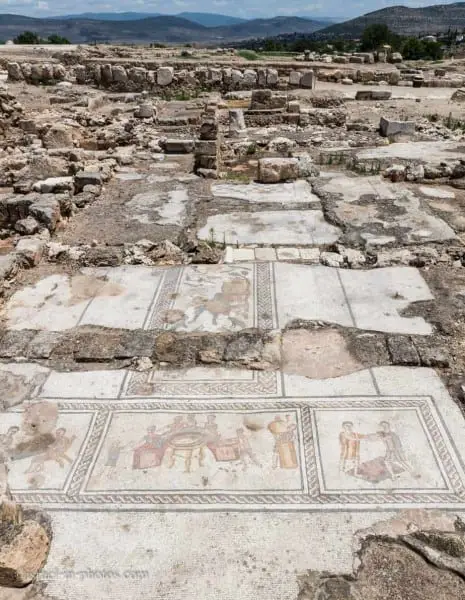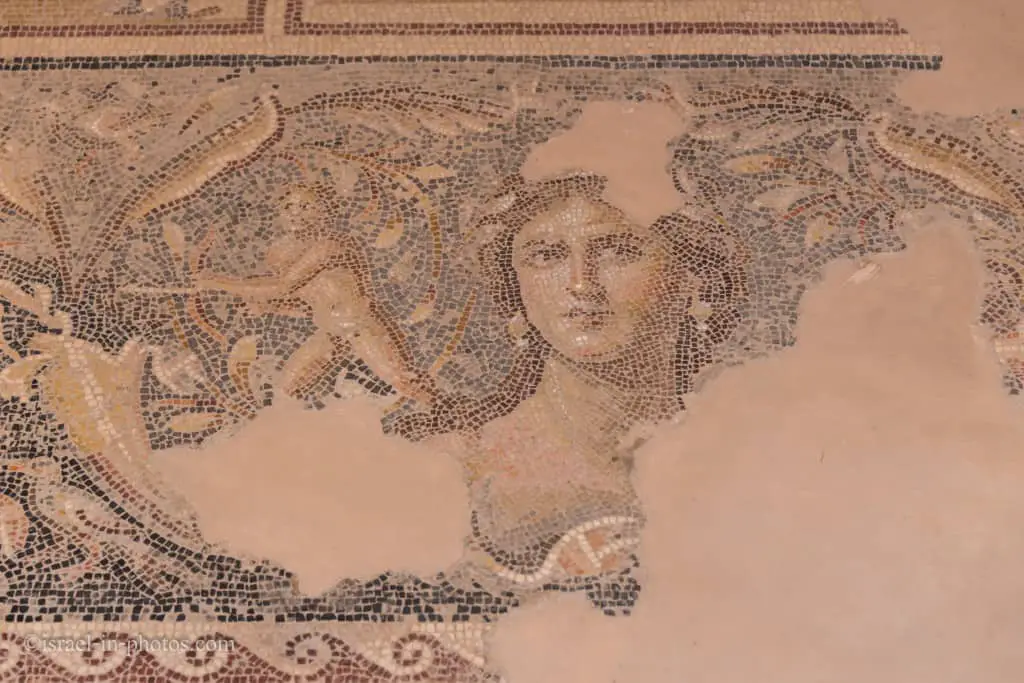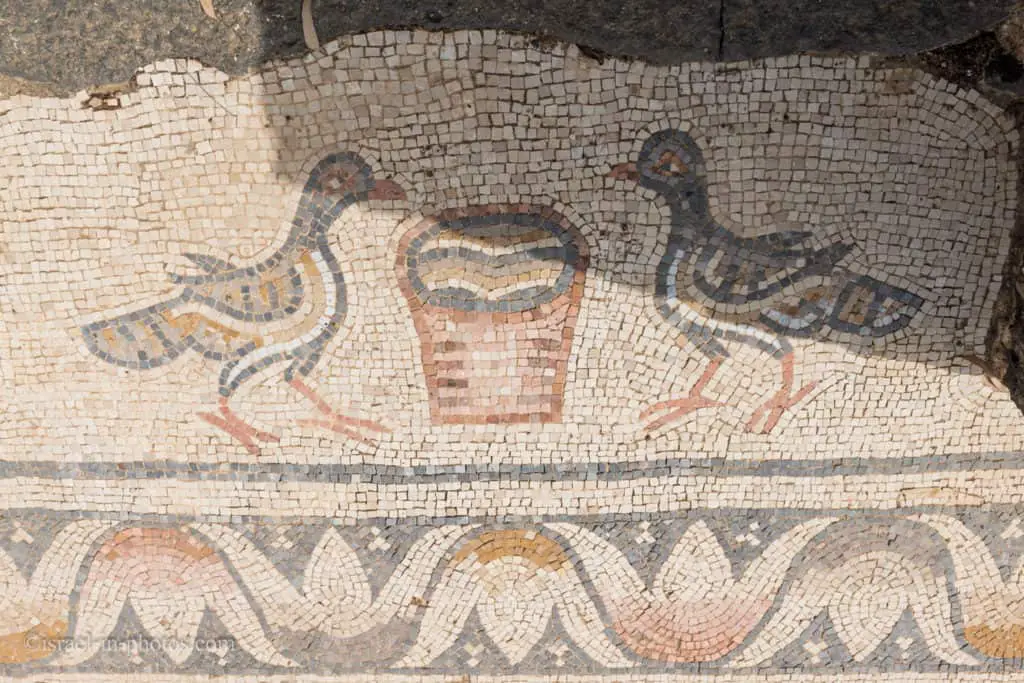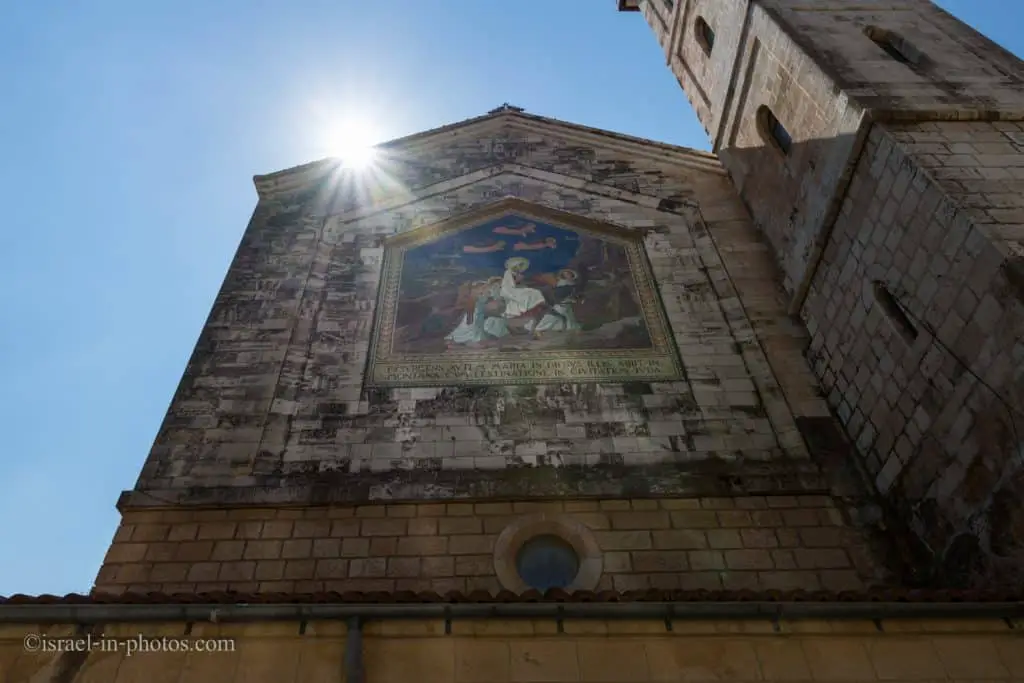Mosaics in Israel – 15+ Places Where You Can See and 20+ Photos
There are many ancient mosaics in Israel. And today, we will go over national parks, churches, and other places where you can see mosaics.
Mosaics in National Parks
Tzipori National Park
When thinking about mosaics, Tzipori National Park is one of the first places that comes to mind. Tzipori National Park presents many remains of the ancient city of Sepphoris, including numerous beautiful mosaics and an ancient water system.
Over sixty different mosaics dating from the third to the sixth century CE can be found across the city.



And now, Dionysus mosaic with Mona Lisa of Galilee – the most famous mosaic at Tzipori National Park.


Beit Alfa Synagogue National Park
Beit Alfa Synagogue National Park is located at a kibbutz with the same name, not far from Beit Shean National Park. And it has one of the most preserved and beautiful mosaics in Israel.
Hamat Tiberias National Park
Hamat Tiberias National Park displays hot springs and rich history, including a stunning zodiac mosaic in the ancient synagogue.

Tel Megiddo National Park
This list would not be complete without mentioning the Earliest Christian Mosaic in Israel. It was discovered near Tel Megiddo National Park. But the problem is that the mosaic was found inside Megiddo prison.
It is believed to be the earliest Christian mosaic in Israel. This mosaic is part of a Roman camp, and it is from the 3rd century. Meaning it was constructed before Romans adopted Christianity (Emperor Constantine issued the Edict of Milan in 313 AD, which accepted Christianity, and ten years later, it had become the official religion).
For additional details, see Tel Megiddo National Park.
Kursi National Park
Kursi National Park contains remains of a Byzantine monastery and is traditionally recognized as where Jesus performed the Miracle of the Swine. And inside the church, you can find mosaic floors.


The Good Samaritan Museum
At The Good Samaritan Museum, you can find a range of beautiful mosaics from Synagogues and Churches of the Byzantine period.
Ein Gedi Nature Reserve
At Ein Gedi Nature Reserve, you can find a beautiful mosaic at the ancient synagogue.


Mamshit National Park
Mamshit National Park is a Nabatean city in the Negev desert. Two impressive churches were discovered in this National Park. And at the “Nile Church”, you can find the following mosaic:
Mosaics in Churches
Tabgha, Church Of The Multiplication
According to tradition, the miracle of the multiplication of the loaves and fishes happened at Tabgha. Now the Church Of The Multiplication and Primacy Of Saint Peter are standing there.
One of the main highlights of the church is its restored 5th-century mosaics. These are the earliest known examples of figurative floor mosaics in Christian art in the Holy Land.
The mosaics in the two transepts depict various wetland birds and plants, with a prominent place given to the lotus flower. This flower, which is not indigenous to the area, suggests the artist’s use of a Nilotic landscape popular in Roman and Early Byzantine art. All the other motifs depict plants and animals from Galilee. The mosaic found in front of the altar shows two fish flanking a basket containing four loaves of bread.
Source: Wikipedia

Church of the Annunciation
According to Catholic tradition, Church of the Annunciation is where the house of the Virgin Mary once stood and where the angel Gabriel appeared to her and announced that she would conceive and bear the Son of God, Jesus.

Church of the Visitation
According to tradition, at the spot of the Church of the Visitation, Mary met her cousin Elizabeth and sang a hymn of praise (the Magnificat).


Horvat Burgin
Horvat Burgin at Adulam forest offers a short loop trail where you will see archaeological remains and visit underground tunnels and caves.

Byzantine-era Church and the Mosaic Floor at Shavei Tzion
Shavei Tzion beach near Nahariya offers stunning beaches with seaside pools. Moreover, near the beach, you can find the mosaic floor of a Byzantine-era church.

Mosaics in Other Places
Lod Mosaic
In 2018, while visiting the Israeli National Maritime Museum in Haifa, we saw the Lod Mosaic.
A routine archaeological inspection carried out in 1996 in Hahalutz Street in Lod (ancient Lydda) and the subsequent rescue excavations carried by Miriam Avisar on behalf of the Israel Antiquities Authority uncovered one of the largest and most impressive mosaics ever found in Israel. Approximately square 160 meters in size, the mosaic is comprised of several panels that depict mammals, birds, fish, sea monsters, merchant ships, and geometric and floral patterns.
The mosaic covered the floors of a large affluent Roman villa and is dated to the late 3rd or early 4th century CE (Late Roman Period).
The National Maritime Museum in Haifa is the first museum in Israel to display any section of The Lod Mosaic. The displayed section depicts a maritime scene with two merchant ships typical of the period and richness of marine life.
Here is only one panel of the 160 square meter mosaic:

A new visitor’s center is built in Lod, where the mosaic was found. It is called Shelby White and Leon Levy Lod Mosaic Archaeological Center, and once construction is finished (the plan was to open it in 2021), the mosaic will be shown there.
Shikmona Mosaics
Also, in the Israeli National Maritime Museum in Haifa, we saw the Shikmona Mosaics (see Tel Shikmona).
Many mosaics from the Byzantine Era were revealed during the excavation of Tel Shikmona. The most spectacular mosaics were found in the northern quarter and among the ruins of a monastery. Here is one of them.

A broader view of the mosaics and the ship models:

Tel Dor
At Hamizgaga Museum, you can find archeological remains from Tel Dor. And one of them is this mosaic floor from Tel Dor:

The exciting thing about this mosaic is that it is made not only of stones but also of glass.
Ein Yael
Ein Yael is a Living Museum.
Ein Yael is situated in the Emek Refaim valley in the heart of nature on the outskirts of Jerusalem. The site includes ancient terraces, a spring, gardens and agricultural areas, and a reconstructed Roman street with shops and workshops. Ein Yael is also home to archaeological remains such as a Roman villa, bathhouses, and impressive mosaics. Each of these areas comes to life through various workshops and activities that focus on ancient crafts and agricultural practices.
Source: itraveljerusalem

Hamat Gader
A stunning mosaic floor was found at the ancient Synagogue of Hamat Gader (near the Roman bath complex). This mosaic was moved, and now you can see it at the Supreme Court entrance in Jerusalem. You can find additional info and see its photo here.
Maon Synagogue
Near Kibbutz Nirim, you can find an archaeological site. You can see the Maon Synagogue at this place with its remarkable mosaic floor (from the 6th century).
Summary
There are many ancient mosaics in Israel. And if you are planning your first visit, I suggest one of the first three places.
Also, please leave a comment below if I missed a relevant place.
That’s all for today, and I’ll see you in future travels!
Stay Tuned!
Additional Resources
Here are several resources that I created to help travelers:- Trip Planner with Attractions and Itineraries is the page that will help you create your perfect travel route.
- What is the Best Time to visit Israel? To answer this question, we will consider the weather, prices, holidays, festivals, and more.
- Information and Tips for Tourists to Israel will answer the most common questions tourists have about Israel (including safety, passports, weather, currency, tipping, electricity, and much more).
- Israel National Parks and Nature Reserves include a complete list, top ten, map, tickets (Israel Pass, Matmon, combo), and campsites.
- If you are looking for things to do, here are the pages for Jerusalem, Tel Aviv, Haifa, Sea Of Galilee, Akko (Acre), Eilat, Nazareth, Safed (Tzfat), and Makhtesh Ramon.










